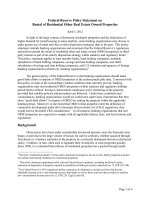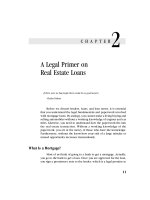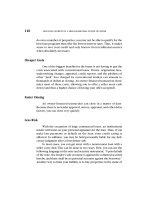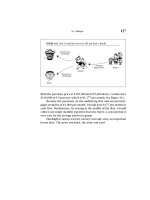Dearborn Financing Secrets of a Millionaire Real Estate Investor 2003_4 pptx
Bạn đang xem bản rút gọn của tài liệu. Xem và tải ngay bản đầy đủ của tài liệu tại đây (594.05 KB, 21 trang )
4/Working with Lenders
53
How do I get negative information removed from my credit
report?
You may find some information on your report that is just
plain wrong. Accounts that are not yours, judgments against people
with similar names, and duplicate items are very common. Some
items are more subtle, such as the fact that a debt is listed as still un-
paid when in fact is was discharged in your bankruptcy. Ask the credit
bureau in writing to reinvestigate the information. Under federal law,
the bureau must reinvestigate and report back within 30 days. In
some states, the law requires a shorter time period. If the bureau does
not report back within the requisite time period, the item must be re-
moved.
If you have “bad” items on your credit report, such as late pay-
ments, charge-offs, judgments, or a bankruptcy, the credit bureaus can
legally report this information. However, if the information is stated in
an incorrect or misleading format, you can still ask the bureaus to re-
investigate the information. Sometimes you will get lucky and the bu-
reau does not report back within the required time period. In this
event, the information must be removed.
Communicating with Credit Bureaus
Send your letter by certified mail, return receipt re-
quested. If you do not get results within the time
period specified by your state law or the FCRA,
you can write a sterner letter threatening to sue un-
der state or federal law. You can also try to contact
the creditor directly. Keep in mind that a creditor
may also be liable for reporting wrong informa-
tion. Before jumping into court, try contacting
your regional Federal Trade Commission office and
your state Attorney General’s Consumer Fraud
Department.
54
FINANCING SECRETS OF A MILLIONAIRE REAL ESTATE INVESTOR
What things affect my credit?
Credit reports are based on a com-
puter model, called a FICO score, developed by Fair Isaac, and Co.
(
FICO, www.fairisaac.com
)
. Although the FICO formula is not gener-
ally known to the public, certain things tend to improve your score,
such as the following:
•
Installment loans
(
e.g., home mortgage, automobile
)
that are
paid on time
•
A few open credit lines with low balances
•
A history of living at the same address
•
Owning a home
Beyond the obvious late payments, judgments, and bankruptcy,
there are certain subtle things that lower your score, such as the
following:
•
Too many revolving credit card accounts
•
Too many inquiries
•
High balances on credit cards
•
Too many recently-opened accounts
Disputing Items on Your Credit Report
Do not be too specific with your request. For ex-
ample, if a bureau reports that you had a judgment
against you and it was paid, do not volunteer that
information
(
a record of a judgment rendered and
paid off is still worse than no judgment in the first
place
)
. Simply state that the information is incom-
plete and request that it be reinvestigated. In some
cases, it is less work for the credit bureau to re-
move the item than to recheck it.
4/Working with Lenders
55
How can I improve my credit?
A good credit score is generally
above 660. Some loans are so stringent that they require a FICO score
above 700. If your score is above 700, you have excellent credit. The
bad news is, if you keep borrowing, your score will fall, even if you
are current on all payments. So, in short, use your credit wisely. You
can check your own FICO score at
<
www.fairisaac.com
>
.
If you do not have late payments but want to improve your credit
score, you should
•
stay away from multiple department store cards—too many
open accounts;
•
bring a copy of your credit report when shopping for a loan—
car dealers may run your credit a dozen times in one day of
shopping, leaving damaging “inquiries.”
•
separate your credit file from your spouse’s and remove each
other’s names from your credit cards; if you have authorization
to use your spouse’s card, it ends up on your credit file, too.
Can I get a loan with bad credit?
Whether you can get a loan
with poor credit depends on the type of loan. Unsecured loans, such
as credit cards and bank signature loans, usually require a good credit
history. Secured loans, such as home mortgages and car loans, are a
bit more flexible. Lenders are more aggressive and will take larger
risks when the loan is secured by collateral. The lender may require a
larger down payment and charge a higher interest rate for the risk of
lending to an individual with poor credit.
56
FINANCING SECRETS OF A MILLIONAIRE REAL ESTATE INVESTOR
Your Provable Income
FNMA loan regulations require proof of requisite income to sup-
port the loan payments. Proof of income requires strict documenta-
tion, such as
•
two years of W-2 forms,
•
past two pay stubs, and
•
two years of tax returns.
If you are self-employed, or at least a 25 percent owner of a bus-
iness, you need to show that you have been in business at least two
years. Proof of self-employment requires copies of tax returns show-
ing the business income.
“I Don’t Like Credit Cards—Should I Pay
Them Off and Cancel Them?”
Never pay off completely or cancel a credit card!
A person with no credit at all is worse off than a
person with a bad credit history. You may think
that credit cards are evil, but you may not be able
to get a phone, a job, or even a utility account
without a credit score. A person with an empty
credit file looks somewhere between “suspicious”
and “scary” to a company inquiring about your
credit. Have a credit card or two, and use them
once or twice a year, even if it is just to pay to fill
up your gas tank.
4/Working with Lenders
57
The Property
An understated point thus far is the property itself. Part of the
lender’s risk analysis is the property they are collateralizing with
the loan. The lender has to keep in the back of its mind the worst-case
scenario: a borrower’s default and ensuing foreclosure. In other
words, the lender asks itself, “Would I want to own this property?”
The appraisal.
The first thing a lender will do is order an ap-
praisal. Some lenders have in-house staff, but most use independent
contractors. Because the appraiser charges his or her fee whether or
not the loan is approved, the lender generally collects the appraisal fee
(
about $350
)
from the borrower up front.
There are three generally accepted approaches to appraising
property: the market data approach, the cost approach, and the in-
come approach.
Market data approach.
The market data approach is the most
commonly used formula for single-family homes, condominiums, and
small apartments. Basically, a licensed appraiser looks at the three
most “similar” houses in the vicinity that have sold recently. He or she
then compares square footage and other attributes. The number of
bedrooms and baths, age of the property, improvements, physical
condition, and the presence of a garage will affect the price, but
square footage is usually the most important factor. As you might
expect, there are exceptions to this rule. For example, the style of
house, its location, and proximity to main roads, and whether it has a
view or beach access will greatly affect the value. For the most part,
however, if you leave these issues aside, square footage, number of
bedrooms and baths, and physical condition are the most relevant fac-
tors. Keep in mind that bedrooms and baths on the main level add
more value than bedrooms and baths in a basement or attic.
The income approach.
With income properties, an appraiser will
also use the income approach method, particularly if comparable
properties are not available for comparison. The income approach is
58
FINANCING SECRETS OF A MILLIONAIRE REAL ESTATE INVESTOR
basically a mathematical formula based on certain presumptions in the
marketplace
(
based, of course, on opinion
)
. The formula is as follows:
Value = Net operating income ÷ Capitalization rate
Net operating income is the potential
(
not actual
)
rents the prop-
erty will command, less average vacancy allowance and operating
expenses. Operating expenses include property management, insur-
ance, property taxes, utilities, maintenance, and the like, but not
mortgage loan payments.
Capitalization rate is a little more subjective and difficult to cal-
culate. Capitalization, or “cap” rate, is the rate of return a particular
investor would expect to receive if he or she purchased a similar
property at a similar price. The cap rate is derived from looking at
similar properties and the net operating income associated with
them. Obviously, estimating cap rate is not an exact science but a
trained guess.
Gross rent multiplier.
For single-family rentals, duplexes, and
other small projects, an appraiser may use the “gross rent multiplier”
to help determine value. This formula basically looks at similar prop-
erties and their rental incomes. By dividing the sales prices of similar
properties by the monthly rent received, the appraiser can come up
with a rough formula to compare with the subject property.
Loan-to-Value
Loan-to-value
(
LTV
)
is an important criterion in determining the
lender’s risk. In maximizing leverage, the investor wants to invest as
little cash as possible. However, the lender’s point of view is that the
more equity in the property, the less of a loss it would take if it had to
foreclose.
FNMA-conforming loan guidelines generally require an investor
to put 20 percent cash down on a purchase, which means an 80 per-
cent LTV. Nonconforming loans may permit as little as 5 percent down
for investors, depending on the financial strength of the borrower.
Thus, an investor with excellent credit and provable source of income
4/Working with Lenders
59
may be able to borrow as much as 95 percent of the purchase price of
an investment property. On the other hand, an investor with mediocre
credit and who is self-employed for a short period of time may be
required to put 20 percent down. There are a hundred variations,
depending on the particular lender’s underwriting criteria.
The Down Payment
You need to show at least two months of bank statements to the
lender to prove that you have the requisite down payment on hand. If
the down payment money suddenly “appeared” in your account, you
need to show where it came from. If it was a gift, for example, from a
relative, you’ll need a letter from that relative stating so. Basically, the
lender wants to make sure you didn’t borrow the money for the down
payment
(
although some lenders will permit you to borrow the down
payment from your home equity line of credit, discussed in Chapter 6
)
.
If your credit report shows recently high balances or a lot of recent
inquiries from credit card companies, this may be a red flag for the
lender. In short, don’t expect to borrow the down payment from a
credit card or other unsecured line and think the lender won’t notice.
Loan-to-Value versus Loan-to-Purchase Price
Loan-to-value is determined by the amount of the
loan compared to the appraised value of the prop-
erty. If the investor is buying a property for less
than the appraised value, then the lender’s LTV cri-
teria should change, correct? Actually, not—most
lenders’ LTV criteria are based on the appraised
value or purchase price, whichever is less. Based
on various studies done by lenders, the statistical
chance of a borrower’s default decreases if the bor-
rower has more of his or her own money invested.
60
FINANCING SECRETS OF A MILLIONAIRE REAL ESTATE INVESTOR
Income Potential and Resale Value of the Property
The particular property being financed is relevant to the lender’s
risk. If the property is a single-family home in a “bread and butter”
neighborhood, the lender’s risk is reduced. Because middle-class
homes in established neighborhoods are easy to sell, a lender feels
secure using them as collateral. However, if the property is in a neigh-
borhood where sales are not brisk, the lender’s risk is increased. Also,
if the property is very old or nonconforming with the neighborhood
(
e.g., one bedroom or very small
)
, then the lender will be tighter with
their underwriting guidelines. On the other hand, the stronger the
local economy, the more likely a lender will be to waive the strictest
of their loan guidelines.
Financing Junker Properties
One of the major headaches you will run into as an investor is try-
ing to finance fixer-upper properties. Many banks shy away from
these loans because a subpar property doesn’t meet the strict FNMA
lending guidelines. Also, lenders based their LTV and down payment
requirements on the purchase price, not the appraisal. Thus, you are
penalized as an investor for getting a good deal.
Example:
A property is worth $100,000 in good shape and
needs $15,000 in repairs. The investor negotiates a purchase
price of $70,000. The lender offers 80% LTV financing,
which should be $80,000, right? Wrong! The lender offers
80% of the purchase price or appraised value, whichever is
less.
So, the lender would expect the borrower to come up
with 20% of $70,000, or $14,000, offering $56,000 in
financing.
Dealing with junker properties requires a lender that understands
what it is you do. A small, locally owned bank that portfolios its loans
will be your best bet. The lender may even lend you the fix-up money
for the deal. An appraisal will be done of the property, noting its cur-
rent value and its value after repairs are complete. The lender will lend
☛
4/Working with Lenders
61
you the money for the purchase, holding the repair money in escrow.
When the repairs are completed, the lender will inspect the property,
then authorize the release of the funds in escrow.
Refinancing—Worth It?
A corollary to financing properties is the concept of refinancing.
When and how often should you refinance your investment proper-
ties? Should you take advantage of falling interest rates?
The rule of thumb is that you should not refinance your loan
unless it is a variable rate or your new rate is 2 percent lower than your
existing rate
(
that is, 2 points lower—not 2 percent of your current
rate—such as 8 percent down to 6 percent
)
. However, this rule of
thumb is just that—a guideline. There are costs involved in getting a
loan, and it takes several years of payments at the lower rate to recoup
your investment. Also, keep in mind that if your existing loan has
been amortized for several years, you are starting to pay less interest
and more principal on your current loan; refinancing means starting
all over again.
The bottom line is to use common sense and a calculator—figure
out whether the interest savings is worth the extra cost
(
and poten-
tially the risk
)
of refinancing.
Filling Out a Loan Application
You should be familiar with FNMA Form 1003, a standard loan
application form used by most mortgage brokers and direct lenders to
gather information about your finances. You should also have one
filled out on your computer that you can provide to your lender
(
you
can download a fillable Form 1003 on my Web site at
<
www.legal
wiz.com/1003.htm
>
. You should always fill out a Form 1003 truth-
fully and honestly, but, like income tax returns, there are many “gray
areas” when it comes to stating your income, debt, and assets. If you
have any doubt, have your mortgage broker review it before submit-
ting it to the lender.
62
FINANCING SECRETS OF A MILLIONAIRE REAL ESTATE INVESTOR
Key Points
•
Lenders make their profit in a variety of ways—the key is under-
standing how they do it, and paying the minimum you need to
get a good loan at a fair price.
•
Choose a mortgage company that has the requisite experience
and can handle your business.
•
Understand the basic loan criteria before you apply for a loan.
•
Refinance only when the numbers make sense.
Cash Out Refinancing
Many investors refinance every few years as prop-
erty values increase, using the extra cash to buy
more properties, as suggested in Robert Allen’s
best-selling book,
Nothing Down for the ’90s.
While this process does increase your leverage, it
also increases your risk. There is nothing inherent-
ly wrong with taking out cash in a refinance, so
long as the cash is used wisely. Spending the mon-
ey as profit is not a smart use. Paying off credit
cards with that money isn’t always a smart use of
cash either because you are taking unsecured debt
and substituting it with secured debt. While it may
seem like the monthly payments are lower, the ex-
pense of the refinance hardly makes it worthwhile.
And if you end up with a high LTV and/or negative
cash flow on the property and housing prices fall,
you are in for a world of financial hurt.
63
CHAPTER
5
Creative Financing through
Institutional Lenders
The power of thought—the magic of the mind!
—Lord Byron
While having a good mortgage broker or lender on your side is
very valuable, you still need to have a few tricks in your back pocket
to make things work. One of the main challenges for the investor is to
buy properties with little or no cash, yet still have a low enough pay-
ment to avoid negative cash flow. This chapter will discuss some of
the ways to do so.
Double Closing—Short-Term Financing without Cash
If your intention is to buy a property and turn it around quickly
for a cash profit, it is almost a sin to pay loan costs. Known as a
flip,
the investor wants to make $5,000 to $10,000 turning a property that
he or she buys at a bargain price. This process can be accomplished
without traditional bank financing, much less a down payment.
64
FINANCING SECRETS OF A MILLIONAIRE REAL ESTATE INVESTOR
If a particular seller and buyer cannot be present at the same time,
a closing can be consummated
in escrow
(
an incomplete transaction,
waiting for certain conditions to be met, such as the funding of a loan
)
.
Thus, the seller can sign a deed and place it into escrow with the clos-
ing agent. When the buyer completes his or her loan transaction, the
deed is delivered and the funds are disbursed. In many cases, you can
buy and sell the property to a third party in a back-to-back
double
closing
(
also called
double escrow
in some states
)
. You do not need
any of your own cash to purchase the property from the owner before
reselling it to another investor/buyer in a double closing.
The seven-step double-closing process works as follows:
1. Party A signs a purchase agreement with party B at a below-
market price.
2. Party B signs a purchase agreement with party C, offering the
property at market price.
3. The only party coming to the table with cash is party C.
Assuming party C is borrowing money from a lender to fund
the transaction, party C’s bank will wire the funds into the
bank account of the closing agent.
4. Party A signs a deed to party B. This deed is
not delivered
but
deposited in escrow with the closing agent. Party B signs a
deed to party C, which is deposited in escrow with the clos-
ing agent.
5. Party C signs the bank loan documents, at which point the
loan is funded and the transaction is complete.
6. The closing agent delivers funds to party A for the purchase
price and the difference to party B.
7. The closing agent records the two deeds one after another at
the county land records office.
5 / Creative Financing through Institutional Lenders
65
As you can see, no cash was required by party B to close the
transaction. Party B’s funds came from the proceeds of the sale from
party B to party C. If the second sale does not happen, the first trans-
action, which is closed in escrow, cannot be completed. At that point,
the deal is dead.
If you are doing a double closing, you are acting as both buyer
and seller. A double closing is actually two separate transactions. If
you do not want party C to meet party A, the double closing can be
completed in two phases rather than all at once. Obviously, you can-
not give the seller funds until your buyer gives you funds. Thus, one
of the two transactions must be closed in escrow until the other is
complete. Often, this escrow closing may last an hour. The bottom
line is you cannot close with the owner if your third-party buyer does
not deliver funds to you.
If you are interested in more information about the flipping pro-
cess, pick up a copy of my book,
Flipping Properties
(
Dearborn Trade,
2001
)
.
Seasoning of Title
In recent years, some lenders have been placing “seasoning”
(
time of ownership
)
requirements on loan transactions. Some lenders
are afraid to fund the second part of a double closing because of the
possibility that the buyer’s purchase price is inflated. The lenders are
acting mostly out of irrational fear because of a recent barrage of real
estate scams reported in the newspapers.
Property flipping scams.
There has been a lot of negative press
lately about double closings. Scores of people have been indicted
under what the press has called “property flipping schemes.” Some
lenders, real estate agents, and title companies will tell you that dou-
ble closings are illegal. In fact, they are nothing of the sort.
The illegal property-flipping schemes work as follows. Unscru-
pulous investors buy cheap, run-down properties in mostly low-
66
FINANCING SECRETS OF A MILLIONAIRE REAL ESTATE INVESTOR
income neighborhoods. After they do shoddy renovations to the prop-
erties, they sell them to unsophisticated buyers at an inflated price.
In most cases, the investor, appraiser, and mortgage broker conspire
by submitting fraudulent loan documents and a bogus appraisal. The
end result is a buyer who has paid too much for a house and cannot
afford the loan. Because many of these loans are FHA-insured, the U.S.
Senate has held hearings to investigate this practice.
Despite the negative press, neither flipping nor double closings
are illegal. The activities described above simply amount to loan
fraud, nothing more. As a result, some lenders have placed seasoning
requirements on the seller’s ownership. If the seller has not owned
the property for at least 12 months, the lender will assume that the
deal is fishy and refuse to fund the buyer’s loan. There really is no solu-
tion to this issue other than to deal with other lenders that don’t have
the seasoning hangup. Make sure you stay in control of the loan pro-
cess and steer your buyers to a mortgage company that doesn’t have a
problem with double closings.
Two possible solutions.
If the buyer has found a lender that is
really stuck on the seasoning issue, you have two options:
(
1
)
assign
your contract to the end-buyer or
(
2
)
have the original owner buy you
out of the deal.
If you assign your contract to your end-buyer, he or she will close
directly with the owner. However, the end-buyer may not have enough
cash to pay you the difference between your purchase price with the
owner and his or her purchase price with you. You need to trust that
the parties involved will pay you at closing from the seller’s proceeds!
The safer way to solve the problem is to approach the owner and
ask him or her to buy you out of the deal.
Buying you out
means that
the owner is going to pay you to cancel the sales agreement with you
so that he or she can enter into a purchase contract directly with your
end-buyer. Ideally, it would be best if the owner paid you in cash
before he or she closed with your end-buyer. If the owner wants to
wait until the end-buyer closes the sale with him or her to pay you the
cash, put the agreement in writing in the form of a promissory note,
5 / Creative Financing through Institutional Lenders
67
secured by a mortgage on the property. Thus, at closing, you will be
paid off as a lien holder.
The Middleman Technique
Many foolish investors and unscrupulous mortgage brokers have
been known to “overappraise” a property, effectively financing a
property for 100 percent of its value. The mortgage broker then
passes the buyer’s down payment back to the buyer under the table so
that the deal is done with nothing down. Not only is this practice ille-
gal, it is foolish, unless the property can be rented for more than the
loan payment.
Again, there is nothing special about buying a property with no
money down unless it is profitable to do so. If you can purchase the
property at a substantially below-market price
and
with no money
down, you then have a good deal. This is buying 100 percent loan to
purchase, not 100 percent loan to value.
The problem with buying a property at a below-market price is
that conventional lenders tend to penalize you with their loan regula-
tions. As discussed earlier, FNMA-conforming loan guidelines usually
require that an investor put up 20 percent of his or her own cash as a
down payment. The 20 percent rule applies even if the purchase price
is half of the property’s appraised value. A common, but illegal, prac-
tice is for the buyer to put up the down payment and for the seller to
give it back to the buyer after closing. People may get away with it all
the time, but this practice is loan fraud.
The middleman technique is a legal way to get around the 20 per-
cent down rule. The process requires the following three important
factors:
1. A middleman buyer
2. A negotiated purchase price that is 10 percent to 20 percent
below market value
68
FINANCING SECRETS OF A MILLIONAIRE REAL ESTATE INVESTOR
3. A lender that does not require evidence of a cash down pay-
ment
Use a middleman partner to buy the house from the owner at a
discount and sell it to you for its full appraised value. Do a double clos-
ing at which time the middleman buys the property and simulta-
neously sells to you. The reason for the middleman buyer is to
increase the purchase price, because most lenders base their LTV on
the lesser of the purchase price or the appraised value. Thus, even if
you negotiate a 20 percent discount in the purchase price, the maxi-
mum loan you can get is based on the purchase price, not the ap-
praised value.
Example:
Sammy Seller has a property worth $100,000 and
is willing to accept $80,000 for an all-cash sale. Matthew
Middleman signs a purchase contract to buy it from Sammy
for $80,000. Matthew Middleman then signs a contract to sell
the same property to Ira Investor for $100,000. The terms of
the contract are $80,000 cash and a note for $20,000, due in
ten years. Ira applies for a loan with First National Bank for
80 percent of the purchase price, or $80,000. At a double
closing, Sammy signs a deed to Matthew, which is held in
escrow. Matthew signs a deed to Ira, which is also held in es-
crow. First National Bank funds the loan by wiring the money
into the account of the escrow agent. The closing agent
writes Sammy a check for $80,000. Ira signs a note to Mat-
thew for $20,000. The closing agent records the two deeds
back-to-back. Sammy gets his $80,000. Ira gets his property
for only a few thousand dollars down
(
his loan costs
)
. Mat-
thew gets a note from Ira for $20,000. See Figure 5.1.
Epilogue:
A month or two after closing, Matthew and
Ira become partners when Ira deeds a one-half interest in
the property to Matthew in exchange for complete satisfac-
tion of the note.
☛
5 / Creative Financing through Institutional Lenders
69
Case Study #1: Tag Team Investing
I stumbled across a property that was bank-owned and offered by
auction to the public. Like many foreclosures, the property was in
need of repair
(
approximately $10,000 worth, in this case
)
. The mar-
FIGURE 5.1
Middleman Double-Closing Technique
Warning:
Keep in mind that you should disclose to
the lender up front that you are not putting up any
cash in the deal. Do not, I repeat, do not pay the
seller cash at closing and take it back under the
table in exchange for a note. This practice is loan
fraud, punishable by up to 30 years in federal pris-
on.
See 18 U.S.C. Sec. 1014.
Deed
Deed
Sammy Seller
Matthew Middleman
Ira Investor
Escrow Agent
70
FINANCING SECRETS OF A MILLIONAIRE REAL ESTATE INVESTOR
ket value of the property in its existing condition was about $180,000.
The bank was willing to accept a bid of $134,000, which was 74 per-
cent of its value.
I brought in a middleman to submit the bid of $134,000 to the
bank. The terms of the offer were all cash, which the lender would
receive, as explained in a moment.
The middleman then signed a contract to sell the property to me
for $180,000. The terms of the sale from the middleman to me were
$9,000 cash and a $27,000 promissory note
(
no payments, interest
only, due in five years
)
. The $27,000 note was to be secured by a sec-
ond mortgage on the property, because I intended to borrow 80 per-
cent of the purchase price
(
$144,000
)
and secure the new loan with
a new first mortgage on the property.
After the double closing, I owned the property subject to a new
first mortgage of $144,000 to an institutional lender and a second
mortgage of $27,000 to the middleman investor. The bank that owned
the property received their $134,000 in cash, and the middleman
investor walked away with about $9,000 in cash. I was out of pocket
about $11,000, which was the down payment
(
$9,000
)
, plus closing
costs
(
$2,000
)
.
I later sold the property for $185,000, at which time the middle-
man investor agreed to accept a 50 percent discount on the $27,000
note. I used proceeds from the sale to pay the middleman. In the
meantime, the payments on the $144,000 first mortgage note were
less than I was able to rent the property for.
Case Study #2: Tag Team Investing
A client of mine
(
we’ll call him Chuck
)
used the middleman
method to buy a $1.6 million house with no money down. The prop-
erty was banked-owned as the result of a foreclosure. Chuck set up a
simple living trust for himself with his buddy as trustee. The trust
signed a contract
(
executed by Chuck’s buddy, the trustee
)
to buy the
house from the bank for $950,000. Chuck then signed a contract to
buy the house from the trust for $1.6 million, the property’s appraised
5 / Creative Financing through Institutional Lenders
71
value. Chuck gave the trust $400,000 cash and borrowed $1.2 million
from an institutional lender. Because Chuck was the beneficiary of the
trust, he received the proceeds of the sale
(
his $400,000 down pay-
ment, plus the $250,000 loan proceeds
)
, netting nearly $250,000 cash
in his pocket. Needless to say, he has yet to reach into his pocket for a
monthly payment on his new loan!
Using Two Mortgages
In the Case Studies above, we got around the 20 percent down
payment financing requirement by using a seller-carryback loan
(
dis-
cussed in more detail in Chapter 9
)
. This type of loan is known as an
80-15-5 loan; you borrow a first mortgage loan for 80 percent of the
purchase price, ask the seller to accept a note for 15 percent of the
purchase price, and put down the balance of 5 percent in cash. There
are many variations to this formula, such as 80-10-10
(
80 percent first
mortgage, 10 percent second mortgage, 10 percent down
)
.
In Case Study #2, the seller accepted a note and second mortgage
for part of the purchase price. The 10 percent
(
or more
)
can also be
borrowed from a third party, such as an institutional lender. The ad-
Walk the Fine Line Carefully
In Chuck’s example, the lender never asked
(
nor
did Chuck misrepresent
)
the relationship between
the trust and himself. However, if the lender does
ask about the relationship between you and the
middleman, be truthful. Don’t mislead or misrep-
resent anything to the lender you are borrowing
from. It’s one thing to be creative with a lender;
it’s another thing to lie.
72
FINANCING SECRETS OF A MILLIONAIRE REAL ESTATE INVESTOR
vantage of using two loans as opposed to one 90 percent or 95 per-
cent LTV loan, is that the underwriting requirements are easier on the
80 percent LTV first mortgage loan
(
and you avoid the PMI require-
ment, discussed in Chapter 3
)
. Generally speaking, nonconforming
lenders aren’t as concerned with the source of the down payment or
whether the borrower offers cash or a note
(
or other financing
)
for
the balance of the purchase price. So long as the primary lender is in
a first mortgage lien position at 80 percent LTV or less, they are fine
with the seller accepting a note or the borrower obtaining some of
the difference in the form of a second mortgage loan.
No Documentation and Nonincome Verification Loans
Conforming loans generally require strict proof of income, as-
sets, and other debts. If, for example, you cannot prove income to a
lender, whether it is because you are self-employed for a short time or
Tax Consequences to the Middleman
You may be wondering, “If the middleman sells the
property to you at a profit, isn’t this taxable in-
come?” Yes and no. Although it looks like a profit
is made, there is no real gain. The middleman, in
Chuck’s case, was a trust of which Chuck was the
taxable owner, so there was no gain. In Case Study
#1, the middleman’s profit was a note, which is an
installment sale. Installment sale income is taxed
when the gain is actually received, not when the
note is executed. In that particular case, no gain
was received until the note was paid in full
(
in my
case, it was only paid 50 percent, which was tax-
able income to the middleman
)
.
5 / Creative Financing through Institutional Lenders
73
can’t otherwise prove income, there are nonincome verification
(
NIV
)
loans.
NIV loans
(
also known as “stated income” loans
)
require less doc-
umentation than traditional loans. Lenders often advertise these pro-
grams as “no doc” loans, meaning the borrower does not have to come
up with any documentation other than a credit report and a loan
application.
Get Out the Calculator
Using a first and second mortgage in lieu of one
larger loan may not make sense until you do the
numbers. Surely, a second mortgage loan as de-
scribed here will carry a higher interest rate be-
cause of the lender’s increased risk of being in
second position. Make sure the “blended” interest
rate between the first and second mortgages does
not exceed what you otherwise would be paying
with a larger, single first mortgage loan. Also, keep
in mind that a larger first mortgage loan may also
mean you are paying private mortgage insurance,
so that must be factored into the monthly payment.
How to Calculate a Blended Interest Rate
Multiply each interest rate times the amount it
relates to the total debt, then add them together.
For example, if you have an $80,000 first mort-
gage loan at 8%, and a $20,000 second mortgage
loan at 10%, the blended rate is
(
8% × .8
)
+
(
10%
× .2
)
= 8.4%.









